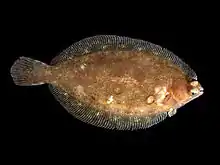Lemon sole
The lemon sole (Microstomus kitt) is a flatfish of the family Pleuronectidae. It is native to shallow seas around Northern Europe, where it lives on stony bottoms down to depths of about 200 metres (660 ft). It grows up to 65 centimetres (26 in) in length and reaches about 3 kilograms (6.6 lb) in weight.[1][2]
| Lemon sole | |
|---|---|
 | |
| Scientific classification | |
| Kingdom: | Animalia |
| Phylum: | Chordata |
| Class: | Actinopterygii |
| Order: | Pleuronectiformes |
| Family: | Pleuronectidae |
| Genus: | Microstomus |
| Species: | M. kitt |
| Binomial name | |
| Microstomus kitt (Walbaum, 1792) | |
 | |
| Range of the lemon sole | |
| Synonyms | |
| |
It is a popular food fish.
Identification
The lemon sole is a right-eyed flatfish with a small head and mouth and smooth, slimy skin. The upper surface is reddish brown in colour, mottled with pink and orange and flecks of yellow and green, and a prominent orange patch is typically found behind the pectoral fin, around which the lateral line also curves. The underside of the fish is white. Adults can reach lengths of up to 65 centimetres (26 in), but most measure around 20–30 centimetres (8–12 in).[1][2]
Origin of the name
The fish is not a true sole, nor does it have the taste of lemon. The English name probably comes from the French name: limande or sole limande. The French term "limande" may come from the French word "lime", meaning "file" (tool used to smooth metal, wood, etc.), possibly referring to the texture of the fish's skin. Some other authors suggest that "limande" may also come from the French word "limon" (which means "silt").[3]
Fishing
In 2007 the European Union fishing quota, or Total Allowable Catch (TAC), for lemon sole (and witch) was 6,175 tonnes, of which 3,716 tonnes were caught, mostly by UK fishermen. The quota for 2008 was 6,793 tonnes and the quota for 2009 was 6,793 tonnes.[4][5]
The Marine Conservation Society rates lemon sole at 3 or 4 on its sustainability scale (where 1 is best and 5 is worst) depending on how and where it is caught.[6][7]
See also
Several other species of flatfish are known as lemon soles:
- English sole, Parophrys vetulus
- Southern lemon sole, Pelotretis flavilatus
- Winter flounder, Pseudopleuronectes americanus
References
- Froese, Rainer and Pauly, Daniel, eds. (2006). "Microstomus kitt" in FishBase. April 2006 version.
- Picton, B.E.; Morrow, C.C. (2005). "Microstomus kitt". Encyclopaedia of Marine Life of Britain and Ireland. Habitas Online. Archived from the original on 2007-12-21. Retrieved 2009-04-28.
- "Limande" in Trésor informatique de la langue française : http://atilf.atilf.fr/dendien/scripts/tlfiv4/showps.exe?p=combi.htm;java=no;
- "1 Fisheries: catch quotas and effort limitation 2009". Documents considered by the Committee on 21 January 2009 - European Scrutiny Committee. Hansard. 21 January 2009. Archived from the original on 3 March 2016. Retrieved 2009-04-27.
- Barratt & Irwin (2008). United Kingdom Sea Fishing Statistics 2007 (PDF). London: Marine and Fisheries Agency. p. 49. ISBN 978-0-85521-181-3.
- "Lemon Sole". Fishonline. Marine Conservation Society. Retrieved 2009-04-27.
- "Fish To Eat: Lemon Sole". Fishonline. Marine Conservation Society. Retrieved 2009-04-27.